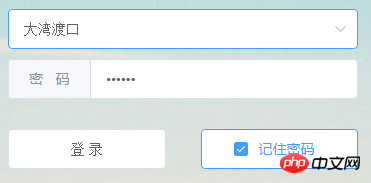Home >Web Front-end >JS Tutorial >How cookies and crypto-js in vue can encrypt and remember passwords
How cookies and crypto-js in vue can encrypt and remember passwords
- 不言Original
- 2018-09-21 17:47:094262browse
This chapter will introduce to you how to use cookies and crypto-js in vue to encrypt and remember passwords. It has certain reference value. Friends in need can refer to it. I hope it will be helpful to you.
Use crypto-js to encrypt and decrypt
The first step is to install
npm install crypto-js
The second step is to import
import CryptoJS from "crypto-js";
in the vue component you need Three steps, use
// Encrypt 加密 var cipherText = CryptoJS.AES.encrypt( "my message", "secretkey123" ).toString(); console.log(cipherText) // Decrypt 解密 var bytes = CryptoJS.AES.decrypt(cipherText, "secretkey123"); var originalText = bytes.toString(CryptoJS.enc.Utf8); console.log(originalText); // 'my message'
Note that mymessage is a string. If you want to encrypt the user ID (number type), you must first convert it to a string
More uses Please visit the official documentation
Remember Password
The implementation principle is that when logging in, if Remember Password is checked (save the 'Remember Password' status to localstorage ) to save the account password to cookies;
When entering the login page, determine whether the password is remembered (judging from localstorage), and if the password is remembered, export the cookies to the form;
The setcookie method is used to save, and the getcookie method is used to retrieve it.
ok, let’s write the method
//设置cookie
setCookie(portId, psw, exdays) {
// Encrypt,加密账号密码
var cipherPortId = CryptoJS.AES.encrypt(
portId+'',
"secretkey123"
).toString();
var cipherPsw = CryptoJS.AES.encrypt(psw+'', "secretkey123").toString();
console.log(cipherPortId+'/'+cipherPsw)//打印一下看看有没有加密成功
var exdate = new Date(); //获取时间
exdate.setTime(exdate.getTime() + 24 * 60 * 60 * 1000 * exdays); //保存的天数
//字符串拼接cookie,为什么这里用了==,因为加密后的字符串也有个=号,影响下面getcookie的字符串切割,你也可以使用更炫酷的符号。
window.document.cookie =
"currentPortId" +
"==" +
cipherPortId +
";path=/;expires=" +
exdate.toGMTString();
window.document.cookie =
"password" +
"==" +
cipherPsw +
";path=/;expires=" +
exdate.toGMTString();
},
//读取cookie
getCookie: function() {
if (document.cookie.length > 0) {
var arr = document.cookie.split("; "); //这里显示的格式请根据自己的代码更改
for (var i = 0; i <p>The login method is as follows: </p><pre class="brush:php;toolbar:false"> login() {
this.$http //请根据实际情况修改该方法
.post(...)
.then(res => {
if (res.data.code == "success") {
if (this.rememberPsw == true) {
//判断用户是否勾选了记住密码选项rememberPsw,传入保存的账号currentPortId,密码password,天数30
this.setCookie(this.currentPortId, this.password, 30);
}else{
this.clearCookie();
}
//这里是因为要在created中判断,所以使用了localstorage比较简单,当然你也可以直接根据cookie的长度or其他骚操作来判断有没有记住密码。
localStorage.setItem("rememberPsw", this.rememberPsw);
} else {
//----
}
})
.catch(err => {
//----
});
},Finally, it is necessary to determine whether the user has remembered the password in the created dog sub-function to perform related operations
//判断是否记住密码
//**注意这里的true是字符串格式,因为Boolean存进localstorage中会变成String**
created() {
//判断是否记住密码
if (localStorage.getItem("rememberPsw") == 'true') {
this.getCookie();
}
}Finally, the interface is pasted, where rememberPsw is the v-model value of the remember password button, currentPortId is the v-model value of the first box, and password is the v-model value of the second box.

The above is the detailed content of How cookies and crypto-js in vue can encrypt and remember passwords. For more information, please follow other related articles on the PHP Chinese website!
Related articles
See more- An in-depth analysis of the Bootstrap list group component
- Detailed explanation of JavaScript function currying
- Complete example of JS password generation and strength detection (with demo source code download)
- Angularjs integrates WeChat UI (weui)
- How to quickly switch between Traditional Chinese and Simplified Chinese with JavaScript and the trick for websites to support switching between Simplified and Traditional Chinese_javascript skills

